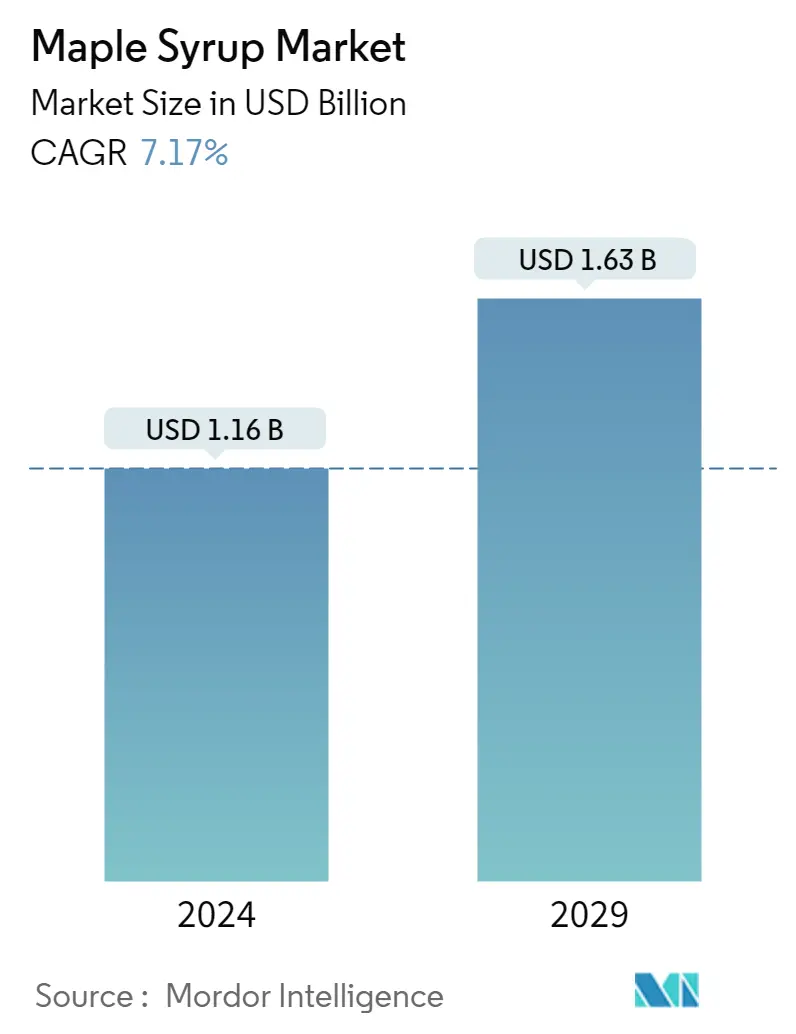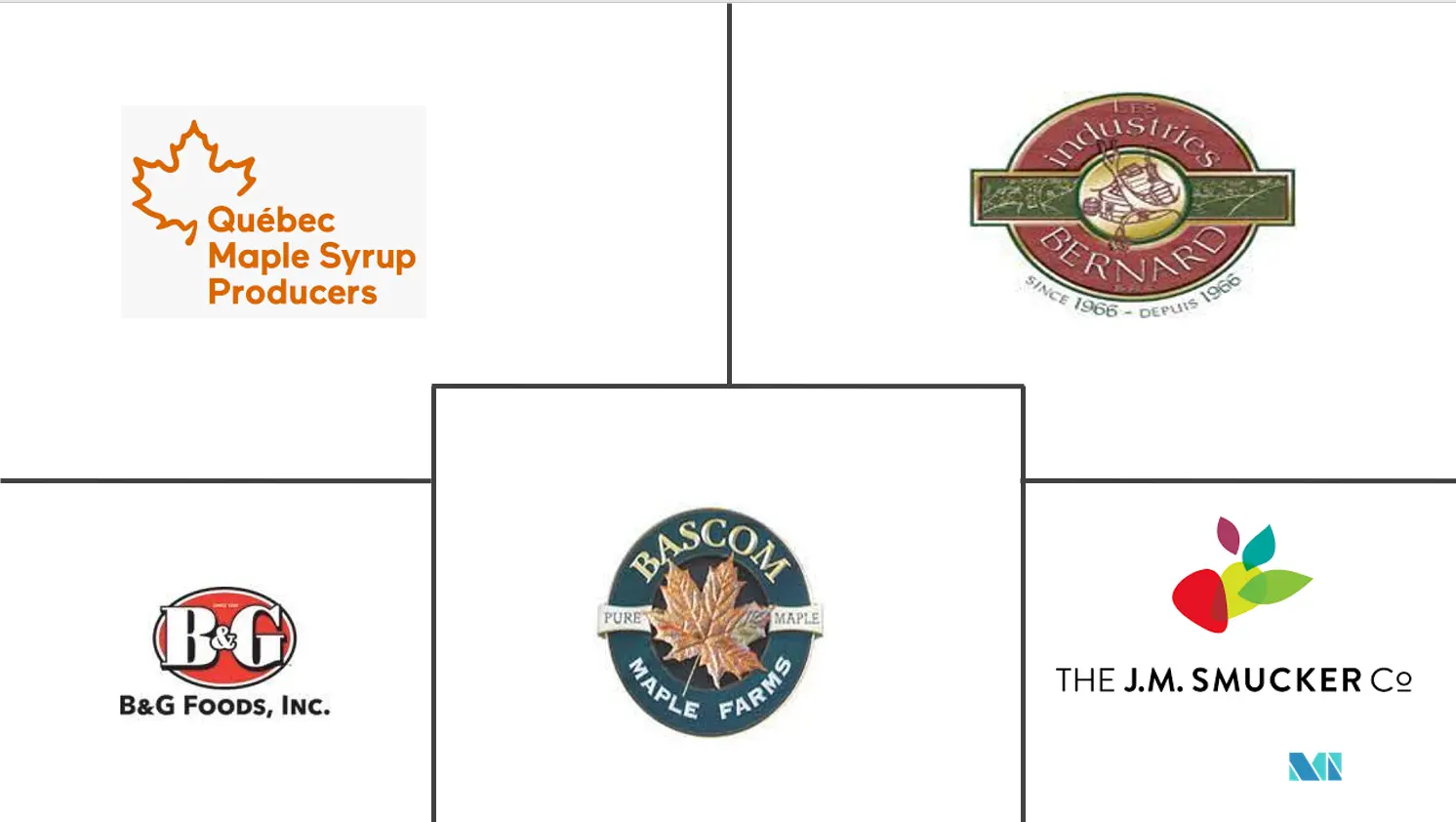Market Size of Maple Syrup Industry

| Study Period | 2019 - 2029 |
| Market Size (2024) | USD 1.16 Billion |
| Market Size (2029) | USD 1.63 Billion |
| CAGR (2024 - 2029) | 7.17 % |
| Fastest Growing Market | Asia-Pacific |
| Largest Market | North America |
Major Players
*Disclaimer: Major Players sorted in no particular order |
Sweet Liquid Market Analysis
The Maple Syrup Market size is estimated at USD 1.16 billion in 2024, and is expected to reach USD 1.63 billion by 2029, growing at a CAGR of 7.17% during the forecast period (2024-2029).
Maple syrup is widely used as a topping for various bakery products, such as waffles, cakes, pancakes, bread rolls, and French toasts. While the increased utilization of maple syrup in the confectionery, bakery, cereal, and dairy industries may likely intensify the demand for maple syrup, growing consumer demand for natural and organic products is also expected to help the sales of maple syrup during the forecast period. The introduction of products like organic maple syrup strengthens the competitive environment in the global market. In addition, numerous customers demonstrate a propensity to try new flavors, and since maple is thought to have a distinctive flavor that works both on its own and when combined with others, maple has an edge over other flavors. In emerging economies, the demand for maple syrup products is driven by the ongoing creation of unique products and eye-catching, inventive packaging. Additionally, a lot of small-scale and giant food producers flavor savory dressings, mustards, sauces, and spices with maple syrup, which promotes the market's expansion. During the projected time period, the market is also expected to grow because major market players will be spending more money on advertising, promotions, and social media marketing.
Consumers' growing preference for natural and organic sweeteners has led to a rise in product acceptance, which is anticipated to fuel market expansion over the course of the projected period. A further factor driving the acceptance of maple syrup as a sugar alternative is the rising prevalence of chronic diseases like diabetes, cardiovascular conditions, and obesity. This trend is expected to continue during the projected years. In nations including the United States, Canada, Germany, the United Kingdom, and France, strict governmental regulations are anticipated to keep these products' quality high. The federal regulations and recommendations that have been made public guarantee that the products meet hygienic requirements for consumption. However, the stringent quota system and the black marketing of maple products are factors impeding the expansion of the market as a whole.
Sweet Liquid Industry Segmentation
Maple syrup is made by concentrating the sap of maple trees, especially sugar maples. It is a sweet, sticky, brown liquid made from the sap of maple trees that can be eaten with pancakes or used to make desserts. Global maple syrup is segmented based on category, type, distribution channel, and geography. By category, the market is segmented into organic and conventional. By type, the market is segmented into black maple, red maple, and sugar maple. By distribution channel, the market is segmented into supermarkets and hypermarkets, convenience and grocery stores, specialty stores, online retail stores, and other distribution channels. Based on geography, the report provides an analysis of North America, Europe, Asia-Pacific, South America, the Middle East, and Africa. The report offers market size and forecasts in value terms (in USD million) for all the above segments.
| Category | |
| Organic | |
| Conventional |
| Type | |
| Black Maple | |
| Red Maple | |
| Sugar Maple |
| Distribution Channel | |
| Supermarket and Hypermarket | |
| Convenience Store | |
| Specialty Stores | |
| Online Retail Stores | |
| Other Distribution Channels |
| Geography | |||||||||
| |||||||||
| |||||||||
| |||||||||
| |||||||||
|
Maple Syrup Market Size Summary
The maple syrup market is poised for significant growth, driven by increasing consumer demand for natural and organic products. This trend is particularly evident in the bakery, confectionery, cereal, and dairy industries, where maple syrup is increasingly used as a topping and flavoring agent. The market is further bolstered by the introduction of organic maple syrup, which enhances the competitive landscape globally. The unique flavor profile of maple syrup, which can stand alone or complement other flavors, gives it an advantage over other sweeteners. Emerging economies are witnessing a surge in demand due to innovative product offerings and attractive packaging. Additionally, the use of maple syrup in savory dressings, mustards, sauces, and spices by both small-scale and large food producers contributes to market expansion. Marketing efforts by major players, including increased spending on advertising and social media, are expected to further drive market growth.
The market's expansion is also supported by a growing preference for natural sweeteners as alternatives to sugar, driven by rising health awareness and the prevalence of chronic diseases such as diabetes and obesity. Strict regulatory standards in countries like the United States, Canada, Germany, the United Kingdom, and France ensure product quality, although challenges such as a stringent quota system and black marketing persist. The North American region, particularly Canada and the United States, remains a dominant force in maple syrup production, with Canada accounting for a significant portion of global output. The competitive landscape is marked by the presence of major players and regional producers, with the Federation of Quebec Maple Syrup Producers playing a pivotal role. Innovations and strategic collaborations, such as PepsiCo's limited-edition maple syrup cola, highlight the dynamic nature of the market.
Maple Syrup Market Size - Table of Contents
-
1. MARKET DYNAMICS
-
1.1 Market Drivers
-
1.2 Market Restraints
-
1.3 Porter's Five Forces Analysis
-
1.3.1 Threat of New Entrants
-
1.3.2 Bargaining Power of Buyers/Consumers
-
1.3.3 Bargaining Power of Suppliers
-
1.3.4 Threat of Substitute Products
-
1.3.5 Intensity of Competitive Rivalry
-
-
-
2. MARKET SEGMENTATION
-
2.1 Category
-
2.1.1 Organic
-
2.1.2 Conventional
-
-
2.2 Type
-
2.2.1 Black Maple
-
2.2.2 Red Maple
-
2.2.3 Sugar Maple
-
-
2.3 Distribution Channel
-
2.3.1 Supermarket and Hypermarket
-
2.3.2 Convenience Store
-
2.3.3 Specialty Stores
-
2.3.4 Online Retail Stores
-
2.3.5 Other Distribution Channels
-
-
2.4 Geography
-
2.4.1 North America
-
2.4.1.1 United States
-
2.4.1.2 Canada
-
2.4.1.3 Mexico
-
2.4.1.4 Rest of North America
-
-
2.4.2 Europe
-
2.4.2.1 Germany
-
2.4.2.2 United Kingdom
-
2.4.2.3 France
-
2.4.2.4 Russia
-
2.4.2.5 Spain
-
2.4.2.6 Italy
-
2.4.2.7 Rest of Europe
-
-
2.4.3 Asia-Pacific
-
2.4.3.1 India
-
2.4.3.2 China
-
2.4.3.3 Japan
-
2.4.3.4 Rest of Asia-Pacific
-
-
2.4.4 South America
-
2.4.4.1 Brazil
-
2.4.4.2 Argentina
-
2.4.4.3 Rest of South America
-
-
2.4.5 Middle-East and Africa
-
2.4.5.1 United Arab Emirates
-
2.4.5.2 South Africa
-
2.4.5.3 Rest of Middle-East and Africa
-
-
-
Maple Syrup Market Size FAQs
How big is the Maple Syrup Market?
The Maple Syrup Market size is expected to reach USD 1.16 billion in 2024 and grow at a CAGR of 7.17% to reach USD 1.63 billion by 2029.
What is the current Maple Syrup Market size?
In 2024, the Maple Syrup Market size is expected to reach USD 1.16 billion.

